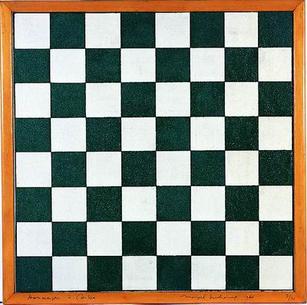Chessboard
The Chessboard is the playing ground for the game of chess and its up to 16 white and black pieces each. It consists of 64 squares, eight rows, called ranks, times eight columns, called files. The squares are alternating dichromatic (light or white, and dark or black squares) on ranks as well on files. Ranks are labeled from '1' to '8', the files from 'A' to 'H' (or with lower case letters 'a' to 'h'), so that each square can be uniquely addressed via concatenated file- and rank labels. The lower left square with the "Address" 'a1' is dark. The diagonals are the north-east directed, distinguished from the anti-diagonals in north-west directions.
Inside a chess program, the chessboard and its piece placement as chess position is subject of the board representation.
Fourfold Symmetry
The chessboard is fourfold symmetrical with respect to rotation about an axis, based on the reflection symmetry of a square (not square of a chessboard but the whole board here). The four axis are the vertical line between the two center-files 'D' and 'E', the horizontal line between the 4th and 5th rank, and the main-diagonal and main-anti-diagonal. The orthogonal symmetrical squares have different, the diagonal symmetrical squares have same square-colors.
See also
- 2D Graphics Board
- 3D Graphics Board
- Squares
- Ranks
- Files
- Diagonals
- Anti-Diagonals
- Board Representation
- Flipping Mirroring and Rotating
- Pieces
- Sensory Board
Publications
- Martin Gardner (1973). Mathematical Games: How to Turn a Chessboard into a Computer to Calculate with Negabinary Numbers. Scientific American, Vol. 228, No. 4 [2]
- Joachim H. Ahrens (1981). Paving the Chessboard. Journal of Combinatorial Theory, Series A, Vol. 31, No. 3
- Noam Elkies (2002). Higher Numbers in pawn endgames on large chessboards. More Games of No Chance edited by Richard J. Nowakowski
External Links
- Chessboard from Wikipedia
- Wheat and chessboard problem
- A Mathematical Chessboard Paradox by Christian Hesse, ChessBase News, March 24, 2009
